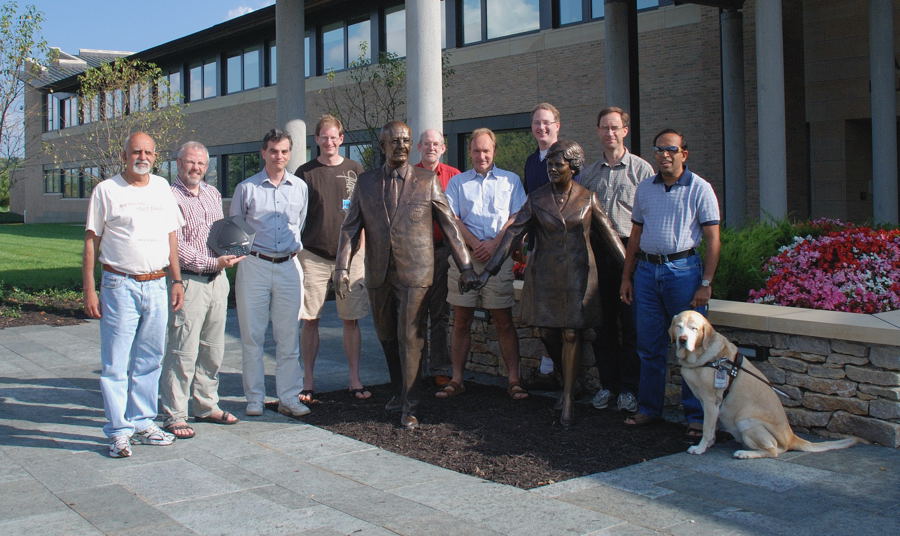
Ashok, Stuart, Norm-by-phone, Noah, Dave, Henry, Tim, Dan, Jonathan, Raman (with Hubbell)
W3C | TAG | Previous teleconference: 11th Sept | Next teleconference: 2nd October 2008.

Ashok, Stuart, Norm-by-phone, Noah, Dave, Henry, Tim, Dan, Jonathan, Raman (with Hubbell)
Nearby: TAG Issues Tracker - findings - www-tag archive - tag archive
| Tue 23rd Sep | Agenda | Minutes |
|---|---|---|
| 09:00-10:30 | Convene URNsAndRegistries-50 binaryXML-30 |
|
| 11:00-12:30 | HTML and Web: the Big Picture | |
| 12:30-13:30 | Lunch | |
| 13:30-15:00 | Modularized HTML5? | |
| 15:30-17:00 | URI parsing in HTML5 | |
| Wed 24th Sep | Minutes | |
| 09:00-10:30 | Self Describing Web | |
| 11:15-12:30 | HTTP and HTML | |
| 12:30-13:30 | Lunch | |
| 13:30-15:00 | HTML5 Embedding and Embedability | |
| 15:30-17:00 | tagSoupIntegration-54: How to move Forward | |
| Thur 25th Sep | Minutes | |
| 09:00-10:30 | passwordsInTheClear-52 | |
| 11:00-12:30 | XMLVersioning-41 | |
| 12:30-13:30 | Lunch | |
| 13:30-15:00 | XMLVersioning-41 (cont) | |
| 15:30-16:00 | Wrapup/AOB |
(also separate Logistics page)
Participants are expected to read materials in the Preparation sections under each item below in advance of the meeting.
TAG members are presumed to be familiar with the TAG Charter.
Our goals for this session is to checks the status of TAG interaction with the EXI-WG; review our progress in reviewing their publications; and discuss a LC review request from the WG.
We are planning to spend a total of 1.5 days on this topic, i.e. half the F2F. The F2F is being organized as 4 90 minute sessions a day, so I'm assuming we get 6 sessions. I'll assign a core issue to each of 4 90 minute sessions, leave the first session for a high-level overview of issues with respect to how design decisions in HTML affect the rest of the Web stack, and leave the final 90 minute session for defining global action items for the TAG. My expectation is that each of the topic-focused 90 minute sessions end with their own action items. T.V. Raman
Note tag-internal discussion of meeting goals Re: updated Agenda 13 Aug and following.
HTML will move to XMLthe question of how other Web technologies integrated with HTML was usually answered by saying
XML will bring it all together.
However, that is no longer the case, there is now little or no hope of the HTML5 world converging with the XML family of languages. HTML5 has an XML serialization that is a second-class citizen at best as far as that community is concerned. In the above I said HTML and Web technologies — but that is just my perspective. The HTML5 community would define themselves as encompassing all Web technologies, i.e., if it's not HTML5 and implemented in a browser, it's not the Web. Personally that is a view that I do not subscribe to, but it's important for the TAG to have thought about where we stand globally on this before we get to concrete details, since one's technical stand on any of the issues that arise is deeply affected by the above.
If you take the world-view that the Web is more than a Web Browser, and that Web technology means more than just HTML, then the core issue that underlies each specific technical issue is the following:
How do you make sure that XML technologies can co-exist on the Web alongside HTML without necessarily having HTML's sloppiness leaking into all Web languages?
Another core issue that lies at the intersection of HTTP and HTML is the issue of:
Content-Type Sniffing
For reference, that's ISSUE-28 http-mime-override in the HTML WG tracker.
Note that a 17 Aug 2007 message from Hickson notes other related sections.
Given CSS and JavaScript, HTML can be reduced to _div_ and _span_.I later revised this to:
display:inline allows you reduce this to just one element --- _div_
Distributed extensibility ends up reducing to a power-struggle between browser vendors who want to dictate what the vocabulary of the Web is — and content creators who do not want to cede this right entirely to the browser. I believe this power struggle to be the root cause of all of the tension that can be observed whenever this issue is brought up.
At this point, I believe we should let the marketplace decide --- it will anyway, with or without the TAG.
But there is a more fundamental design issue that needs to be addressed in this context with respect to the top-level co-existence question we asked in our first session:
Embedding And Embeddability
Our goal for this session is to reach agreement to publish the TAG Finding titled: The Self-Describing Web. Norm Walsh and Stuart Williams took an action in Bristol to do reviews, and the results of those reviews were generally supportive of publication (Norm's review, Stuart's original review and Stuart's followups here, here, and here).
The principle question that's still known to be a point of debate is whether the normative specifications do or
do not suport the claim that RDFa embedded in an application/xhtml+xml document retrieved via HTTP is
self-describing, in the sense that the server can be held responsible for triples inferred from the RDFa. See email from Noah, as well messages linked from
that email, and others in the same threads.
Our goal for this session is to review the most recent draft of the related draft finding and the message that we want it to convey.
Our goals for this session are: to further expand the body of text in the Compatibility Strategies draft finding supported by the TAG; to consider whether the finding needs to include any particular formalism either by inclusion or by reference.